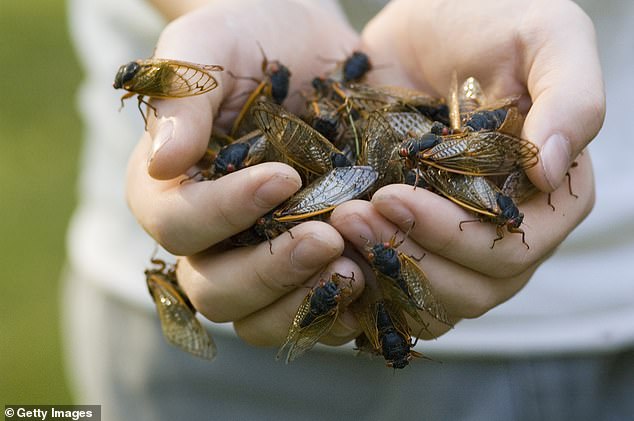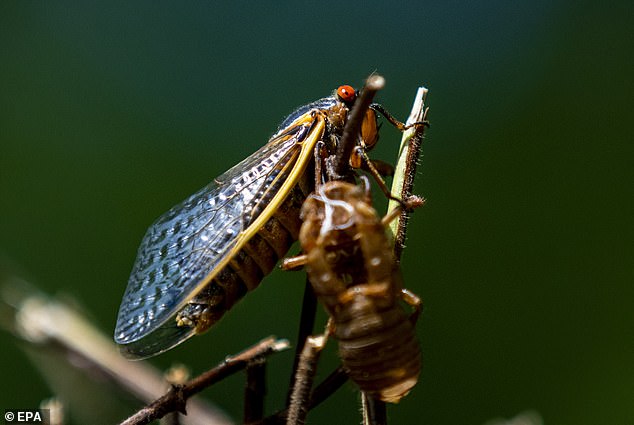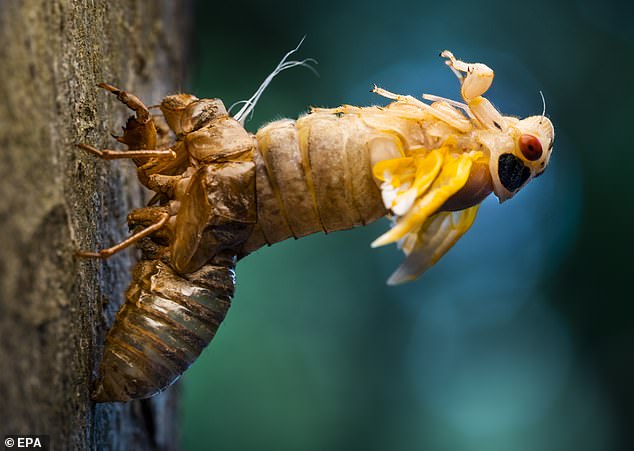America’s Cicada ‘apocalypse’: 200-year event will see one trillion insects from two groups infest 16 states… and our map shows the hotspots
A cicada apocalypse is coming to the US, which will see more than a trillion of the curious, red-eyed insects emerge from the ground.
This year, for the first time since Thomas Jefferson became president in 1803, two groups will surface.
The winged insects hibernate in 13- or 17-year cycles, but the state will soon be abuzz with both — and experts have predicted there will be a million of them per acre of land.
The blight will occur in 16 states and will likely result in hundreds, if not thousands, of trees being “irreparably damaged,” a professor at Tennessee Tech University has warned.
Contagion is planned for 16 states, with some states like Illinois and Indiana seeing both groups around the same time
Floyd W. Shockley, an entomologist at the Smithsonian National Museum of Natural History, told the New York Times: ‘No one alive today will see it happen again.
“That’s actually quite humiliating.”
Shockley also noted that the double appearance means the 16 states could see more than a trillion cicadas, which is enough to cover 15.7 million miles of land if connected end to end.
“That cicada train would go to the moon and back 33 times,” he told the New York Times.
Brood

The curious, winged, red-eyed insects hibernate in 13- or 17-year cycles, but the state will soon be bustling with both — and experts have predicted there will be a million of them per acre of land

The soil will first need to reach the perfect temperature of 64 degrees Fahrenheit at a depth of 12 to 18 inches in the ground before the insects emerge. Soil temperatures act as a signal to crickets, letting them know that the outside world is optimal for survival
The other group, Brood XIII, has a seventeen-year cycle and last peaked in 2007.
States slated for Brood XIII include Illinois, Indiana, Iowa and Wisconsin.
Brood XIX, known as the Northern Illinois Brood, contains three different species of crickets and the Great Southern Brood, or Brood XIII, has four different species.
Shockley told NPR that Brood XIX will begin their great escape from the ground closer to mid-May.
And will be mainly in the Midwestern states.
Brood XIII will emerge from the ground in late April through the second week of May.
This group will mainly occur in the southern states.
The soil will first need to reach the perfect temperature of 64 degrees Fahrenheit at a depth of 12 to 18 inches in the ground before the insects emerge.
Soil temperatures act as a signal to crickets, letting them know that the outside world is optimal for survival, but cold is not a cicada killer.
The timing of these creatures’ emergence from their submerged worlds remains a mystery, but scientists theorize that they developed this tactic to avoid predators.

What makes these creatures so interesting is the ability to harden their exoskeletons, which takes about five days, and shed them in order to fly.

The two broods are expected to live about a month, but due to the large number of insects, Shockley believes there will be “sufficient numbers to necessitate removal of their bodies” in urban areas.
“It’s cold now, but the cicada apocalypse is coming this summer,” reads one post on Reddit.
“This will be a unique double emergence of large broods across much of the Midwest.”
Experts have predicted that forested areas, including urban green areas, will see greater infestation than agricultural regions.
However, for humans, the insects are mainly a nuisance and not so much a danger.
Cicadas do not transmit diseases, but they make crevices in tree branches to lay their eggs.
Those splits weaken the tree over time, leading to branches breaking.
Cicadas prefer specific trees such as oak, maple and some fruit trees such as cherry and pear.
Due to the diameter, the insects are also attracted to younger trees.
People who have recently planted trees can wrap the branches in mesh to keep the crickets at bay.
“In general, mature trees can sustain minor damage from crickets,” according to Davey, a professional tree service company based in Ohio.
‘However, young trees may experience leaf loss and a reduction in photosynthesis due to their limited number of branches.’
More than 3,000 species of crickets are known.
The crickets form 15 large ‘broods’ of crickets in different geographical areas.
These insects emerge from the ground in large numbers, with some years seeing trillions of crickets per season.
What makes these creatures so interesting is the ability to harden their exoskeletons, which takes about five days, and shed them in order to fly.
The two broods are expected to live for about a month, but due to the large number of insects, Shockley believes there will be “sufficient numbers to necessitate removal of their bodies” in urban areas.
“But instead of throwing away the rubbish or cleaning it up with street sweepers, people should basically consider these as free fertilizer for the plants in their gardens and nature reserves,” he said.
The loud gesture is only done by men as a way to attract a mate.
After the mating call captures a female, the pair mates and the female lays eggs in the tree.
The nymphs then fall away and burrow underground to begin their own hibernation – and the cycle begins again.
